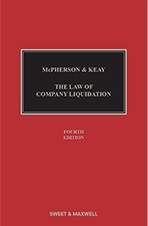Description
This title discusses the legal considerations involved in company liquidation and addresses the various methods of winding-up. It covers the legal considerations to be taken into account in relation to creditors’ petitions and miscellaneous other petitions. It explains provisional liquidation, analyzes the role and duties of the liquidator as well as the role of creditors, and addresses the distribution of a company’s assets in both insolvent and solvent liquidations. It also provides guidance on investigations and examinations and discusses misconduct and prosecutions, as well as actions that can be taken by liquidators to recover assets and the international aspects of liquidations.
Key selling points
- Examines the various means and modes by which a company can be wound-up, including in depth analysis at a general level of: creditors, court and members’ winding up procedures.
- Includes a detailed examination of the effects of liquidation on the company, creditors, members, legal actions etc including an in-depth consideration of the stay that is created on proceedings when a company entering liquidation
- Provides an extremely detailed analysis of actions that are available to liquidators, including those in relation to transactional avoidance, wrongful trading and breach of directors’ duties
- Explains the dissolution process and the restoration of companies that have been dissolved so that they might be liquidated
- Provides a discussion of the international and cross-border elements of liquidation post Brexit, by consideration of the EU Insolvency Regulations and the UNCITRAL Model law.
New to this edition
Explains the effects of Brexit on liquidations and the issues that now confront liquidators both in English liquidations and those European liquidations where there is an English element.
Examines the effects of the Corporate Insolvency and Governance Act 2020 as far as it affects liquidations as well as the amendments made by the various subsequent regulations.
Discusses, at appropriate points, significant parts of the Practice Direction: Insolvency Proceedings 2018 and its impact on liquidations.
Outlines the changes to the rules on preferential creditors and the re-introduction of a limited Crown priority effected by a combination of the Finance Act 2020 and the Insolvency Act 1986 (HMRC Debts: Priority on Insolvency) Regulations 2020
Provides new sections on: the respondent’s private information in the context of private examinations; witness immunity in private examinations; applications to subject foreign residents to private examinations; effects of restoration following dissolution; special purpose appointment liquidators; the rule in Ex parte James.
Considers the latest leading appellate decisions affecting liquidations, including Bresco Electrical Services Ltd (In Liquidation) v Michael J Lonsdale (Electrical) Ltd (adjudication where a company is in insolvent liquidation), Joint Administrators of Lehman Brothers International (Europe) (in admin.) v HM Revenue and Customs Commissioners (statutory interest payable to creditors on their debts owed), Botleigh Grange Hotels Ltd v Revenue and Customs Commissioners (disputed debts on a petition), Bakhshiyeva v Sberbank of Russia; ; Re OJSV International Bank of Azerbaijan (cross-border insolvency), Chu v Lau (just and equitable winding-up petitions), Officeserve Technologies Ltd v Anthony-Mike and Ahmed v Ingram (void dispositions), Fakhry v Pagden (who may apply to remove a liquidator and restoration of dissolved companies), BTI 2014 LLC v Sequana SA (s.423 and duty to take into account creditors’ interests), Skandinaviska Enskilda Banken AB v Conway (avoidance provisions), Ezair v Conn (collection of company property and private examinations), JSC BTA Bank v Ablyazov (transactions defrauding creditors), Leon v Attorney-General (disclaimer and dissolution), Re Paramount Powders (UK) Ltd (petitions on just and equitable ground), Al Jaber v Mitchell (witness immunity in examinations) and Re Peak Hotels and Resorts Ltd (invalidation of charges).
- Contents:
- Chapter 1 – Introduction
- Chapter 2 – Modes of Winding Up
- Chapter 3 – Creditor’s Petition for a Winding-up Order
- Chapter 4 – Contributory’s Petition
- Chapter 5 – Miscellaneous Other Petitions
- Chapter 6 – Provisional Liquidation
- Chapter 7 – Commencement and Effect of Winding Up
- Chapter 8 – Administrative Organs of Winding Up
- Chapter 9 – Functions of the Liquidator
- Chapter 10 – Contributories
- Chapter 11 – Assets Available for Division and Distribution
- Chapter 12 – Creditors
- Chapter 13 – Division of Assets Among Creditors
- Chapter 14 – Distribution of Surplus Assets
- Chapter 15 – Investigations and Examinations
- Chapter 16 – Misconduct and Prosecutions
- Chapter 17 – The Conclusion of Winding-up Proceedings
- Chapter 18 – International Aspects of Liquidations


Reviews
There are no reviews yet.